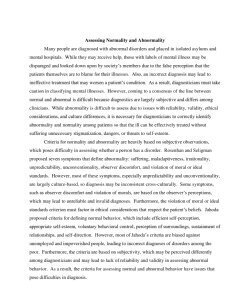Assessing Normality and Abnormality Many people are diagnosed with abnormal disorders and placed in isolated asylums and mental hospitals. While they may receive help, those with labels of mental il
Assessing Normality and Abnormality Many people are diagnosed with abnormal disorders and placed in isolated asylums and mental hospitals. While they may receive help, those with labels of mental il
Assessing Normality and Abnormality
Many people are diagnosed with abnormal disorders and placed in isolated asylums and mental hospitals. While they may receive help, those with labels of mental illness may be disparaged and looked down upon by society’s members due to the false perception that the patients themselves are to blame for their illnesses. Also, an incorrect diagnosis may lead to ineffective treatment that may worsen a patient’s condition. As a result, diagnosticians must take caution in classifying mental illnesses. However, coming to a consensus of the line between normal and abnormal is difficult because diagnostics are largely subjective and differs among clinicians. While abnormality is difficult to assess due to issues with reliability, validity, ethical considerations, and culture differences, it is necessary for diagnosticians to correctly identify abnormality and normality among patients so that the ill can be effectively treated without suffering unnecessary stigmatization, dangers, or threats to self-esteem.
Criteria for normality and abnormality are heavily based on subjective observations,
